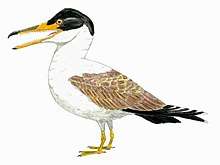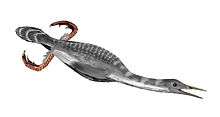Troodontidae
Troodontidae /troʊ.əˈdɒntɪdiː/ is a family of bird-like theropod dinosaurs. During most of the 20th century, troodontid fossils were few and incomplete and they have therefore been allied, at various times, with many dinosaurian lineages. More recent fossil discoveries of complete and articulated specimens (including specimens which preserve feathers, eggs, embryos, and complete juveniles), have helped to increase understanding about this group. Anatomical studies, particularly studies of the most primitive troodontids, like Sinovenator, demonstrate striking anatomical similarities with Archaeopteryx and primitive dromaeosaurids, and demonstrate that they are relatives comprising a clade called Paraves.
| Troodontids | |
|---|---|
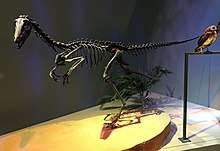 | |
| Mounted skeletal cast of an unnamed Alaskan troodontid, Perot Museum | |
| Scientific classification | |
| Kingdom: | Animalia |
| Phylum: | Chordata |
| Clade: | Dinosauria |
| Clade: | Saurischia |
| Clade: | Theropoda |
| Clade: | Eumaniraptora |
| Family: | †Troodontidae Gilmore, 1924 |
| Type species | |
| †Troodon formosus Leidy, 1856 | |
| Subgroups | |
| Synonyms | |
| |
Physical characteristics
Troodontids are a group of small, bird-like, gracile maniraptorans. All troodontids have unique features of the skull, such as large numbers of closely spaced teeth in the lower jaw. Troodontids have sickle-claws and raptorial hands, and some of the highest non-avian encephalization quotients, suggesting that they were behaviourally advanced and had keen senses.[1] They had unusually long legs compared to other theropods, with a large, curved claw on their retractable second toes, similar to the "sickle-claw" of the dromaeosaurids. However, the sickle-claws of troodontids were not as large or recurved as in dromaeosaurids, and in some instances could not be held off the ground and "retracted" to the same degree. In at least one troodontid, Borogovia, the second toe could not be held far off the ground at all and the claw was straight, not curved or sickle-like.
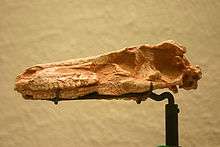
Troodontids had unusually large brains among dinosaurs, comparable to those of living flightless birds. Their eyes were also large, and pointed forward, indicating that they had good binocular vision. The ears of troodontids were also unusual among theropods, having enlarged middle ear cavities, indicating acute hearing ability. The placement of this cavity near the eardrum may have aided in the detection of low-frequency sounds.[2] In some troodontids, ears were also asymmetrical, with one ear placed higher on the skull than the other, a feature shared only with some owls. The specialization of the ears may indicate that troodontids hunted in a manner similar to owls, using their hearing to locate small prey.[3]
Although most paleontologists believe that they were predatory carnivores, the many small, coarsely serrated teeth, large denticle size, and U-shaped jaws of some species (particularly Troodon) suggest that some species may have been omnivorous or herbivorous. Some suggest that the large denticle size is reminiscent of the teeth of extant iguanine lizards.[4][5] In contrast, a few species, such as Byronosaurus, had large numbers of needle-like teeth, which seem best-suited for picking up small prey, such as birds, lizards and small mammals. Other morphological characteristics of the teeth, such as the detailed form of the denticles and the presence of blood grooves, also seem to indicate carnivory.[6] Though little is known directly about the predatory behavior of troodontids, Fowler and colleagues theorize that the longer legs and smaller sickle claws (as compared to dromaeosaurids) indicate a more cursorial lifestyle, though the study indicates that troodontids were still likely to have used the unguals for prey manipulation. The proportions of the metatarsals, tarsals and unguals of troodontids appear indicative of their having nimbler, but weaker feet, perhaps better adapted for capturing and subduing smaller prey. This suggests an ecological separation from the slower but more powerful Dromaeosauridae.[7]
Paleobiology
Many troodontid nests, including eggs that contain fossilized embryos, have been described. Hypotheses about troodontid reproduction have been developed from this evidence (see Troodon).
A few troodont fossils, including specimens of Mei and Sinornithoides, demonstrate that these animals roosted like birds, with their heads tucked under their forelimbs.[8] These fossils, as well as numerous skeletal similarities to birds and related feathered dinosaurs, support the idea that troodontids probably bore a bird-like feathered coat. The discovery of fully feathered, primitive troodontids, such as Jianianhualong, lend support to this.
In 2004, Mark Norell and colleagues described two partial troodontid skulls (specimen numbers IGM 100/972 and IGM 100/974) found in a nest of oviraptorid eggs in the Djadokhta Formation of Mongolia. The nest is quite certainly that of an oviraptorosaur, since an oviraptorid embryo is still preserved inside one of the eggs. The two partial troodontid skulls were first described by Norell et al. (1994) as dromaeosaurids, but reassigned to the troodontid Byronosaurus after further study.[4][9] The troodontids were either hatchlings or embryos, and fragments of eggshell are adhered to them although it seems to be oviraptorid eggshell. The presence of tiny troodontids in an oviraptorid nest is an enigma. Hypotheses explaining how they came to be there include that they were the prey of the adult oviraptorid, that they were there to prey on oviraptorid hatchlings, or that some troodontids may have been nest parasites.[10]
Troodontid feeding was discovered to be typical of coelurosaurian theropods, with a characteristic "puncture and pull" feeding method seen also in such theropods as the dromaeosauridae and tyrannosauridae. Studies of wear patterns on the teeth of dromaeosaurids by Angelica Torices et al., indicate that dromaeosaurid teeth share similar wear patterns to those seen in the aforementioned groups. However, micro wear on the teeth indicated that dromaeosaurids likely preferred larger prey items than the troodontids with which they often shared their environment. Such differences in dietary preferences likely allowed them to inhabit the same ecosystems. The same study also indicated that dromaeosaurids such as Dromaeosaurus and Saurornitholestes (two dromaeosaurids analyzed in the study) likely included bone in their diet and were better adapted to handle struggling prey while troodontids, equipped with weaker jaws, preyed on softer-bodied animals and prey items such as invertebrates and carrion that either was immobile or could likely be swallowed whole.[11][12]
Troodontids and bird evolution
Troodontids are important in research into the origin of birds because they share many anatomical characters with early birds. Crucially, the substantially complete Hesperornithoides ("Lori") is a troodontid from the Late Jurassic Morrison Formation, close to the time of Archaeopteryx. The discovery of Jurassic troodonts is positive physical evidence that derived deinonychosaurs were present before the time that avians arose. This fact strongly invalidates the "temporal paradox" cited by the few remaining opponents of the idea that birds are closely related to dinosaurs.[13]
Flight
Compared to most other paravians, troodontids are unspecialised for aerial locomotion. However, Jinfengopteryx ranks closely with non-avian theropods known to engage in powered flight like Microraptor and Rahonavis.[14]
Classification
Troodontid fossils were among the first dinosaur remains described. Initially, Leidy (1856) assumed they were lacertilian (lizards), but, by 1924, they were referred to Dinosauria by Gilmore, who suggested that they were ornithischians and allied them with the pachycephalosaurian Stegoceras in a Troodontidae. It was not until 1945 that C.M. Sternberg recognized Troodontidae as a theropod family. Since 1969, Troodontidae has typically been allied with Dromaeosauridae, in a clade (natural group) known as Deinonychosauria, but this was by no means a consensus. Holtz (in 1994) erected the clade Bullatosauria, uniting Ornithomimosauria (the "ostrich-dinosaurs") and Troodontidae, on the basis of characteristics including, among others, an inflated braincase (parabasisphenoid) and a long, low opening in the upper jaw (the maxillary fenestra). Features of the pelvis also suggested they were less advanced than dromaeosaurids. New discoveries of primitive troodontids from China (such as Sinovenator and Mei), however, display strong similarities between Troodontidae, Dromaeosauridae and the primitive bird Archaeopteryx, and most paleontologists, including Holtz, now consider troodontids to be much more closely related to birds than they are to ornithomimosaurs, causing the clade Bullatosauria to be abandoned.
One study of theropod systematics by members of the Theropod Working Group has uncovered striking similarities among the most basal dromaeosaurids, troodontids, and Archaeopteryx. This clade is together called Paraves by Novas and Pol.[15] The cladogram published in Hwang et al. found that Archaeopteryx represents a more basal branch of Paraves, and places dromaeosaurids and troodontids as more derived. This raises the possibility that aerodynamic behaviors could be ancestral to all of Deinonychosauria.[16] The extensive cladistic analysis conducted by Turner et al. (2012) supported the monophyly of Troodontidae.[17]
Relationships
There are multiple possibilities of the genera included in Troodontidae as well as how they are related. Very primitive species, such as Anchiornis huxleyi, have alternately been found to be early troodontids, early members of the closely related group Avialae, or more primitive paravians by various studies. The cladogram below follows the results of a study by Lefèvre et al 2017.[18]
| Eumaniraptora |
| |||||||||||||||||||||||||||||||||||||||||||||||||||||||||||||||||||||
Shen et al. (2017a) explored troodontid phylogeny using a modified version of the Tsuihiji et al. (2014) analysis.[19] It was in turn based on data published by Gao et al. (2012), a slightly modified version of the Xu et al. (2011) analysis,[20] focusing on advanced troodontids. A simplified version is shown below.[21]
| Deinonychosauria |
| |||||||||||||||||||||||||||||||||||||||||||||||||||||||||||||||||||||||||||||||||||||||||||||
In 2014, Brusatte, Lloyd, Wang and Norell published an analysis on Coelurosauria, based on data from Turner et al. (2012) who named a third subfamily of troodontids, Jinfengopteryginae.[17] Their analysis included more basal troodontid species but failed to resolve many of their interrelationships, resulting in large "polytomies" (sets of species where the branching order in the family tree is uncertain).[22] An updated version of the Brusatte et al. analysis was provided by Shen et at. (2017b), who included more taxa and recovered greater resolution. Shen et at. named a fourth subfamily of troodontids, the Sinovenatorinae. A simplified version of their analysis is shown below.[23]
| Deinonychosauria |
| |||||||||||||||||||||||||||||||||||||||||||||||||||||||||||||||||||||||||||||||||||||||||||||
Taxonomy
- Family Troodontidae
- †Albertavenator
- †Almas
- †Geminiraptor
- †Jianianhualong
- †Liaoningvenator
- †Sinornithoides
- †Talos
- †Tochisaurus
- †Xixiasaurus
- Subfamily Jinfengopteryginae
- †Jinfengopteryx
- IGM 100/1128
- Subfamily Sinovenatorinae
- †Daliansaurus
- †Mei
- †Sinovenator
- †Sinusonasus
- Subfamily Troodontinae
See also
References
- Junchang Lü; Li Xu; Yongqing Liu; Xingliao Zhang; Songhai Jia & Qiang Ji (2010). "A new troodontid (Theropoda: Troodontidae) from the Late Cretaceous of central China, and the radiation of Asian troodontids" (PDF). Acta Palaeontologica Polonica. 55 (3): 381–388. doi:10.4202/app.2009.0047.
- Currie, P. J. (1985). "Cranial anatomy of Stenonychosaurus inequalis (Saurischia, Theropoda) and its bearing on the origin of birds". Canadian Journal of Earth Sciences. 22 (11): 1643–1658. doi:10.1139/e85-173.
- Castanhinha, R.; Mateus, O. (2006). "On the left-right asymmetry in dinosaurs". Journal of Vertebrate Paleontology. 26 (Supp. 3): 48A. doi:10.1080/02724634.2006.10010069.
- Mackovicky, Peter J.; Norell, Mark A. (2004). "Troodontidae". In Weishampel, David B.; Dodson, Peter; Osmólska, Halszka (eds.). The Dinosauria (2nd ed.). Berkeley: University of California Press. pp. 184–195. ISBN 978-0-520-24209-8.
- Holtz, T.R. Jr.; Brinkman, D.L.; Chandler, C.L. (1998). "Denticle morphometrics and a possibly omnivorous feeding habit for the theropod dinosaur Troodon" (PDF). Gaia. 15: 159–166.
- Currie, PJ; Dong, Z (2001). "New information on Cretaceous troodontids (Dinosauria, Theropoda) from the People's Republic of China". Canadian Journal of Earth Sciences. 38 (12): 1753–1766. doi:10.1139/e01-065.
- Fowler, D.W.; Freedman, E.A.; Scannella, J.B.; Kambic, R.E. (2011). "The Predatory Ecology of Deinonychus and the Origin of Flapping in Birds". PLoS ONE. 6 (12): e28964. doi:10.1371/journal.pone.0028964. PMC 3237572. PMID 22194962.
- Xu; Norell (2004). "A new troodontid dinosaur from China with avian-like sleeping posture". Nature. 431 (7010): 838–841. doi:10.1038/nature02898. PMID 15483610.
- Bever, G.S.; Norell, M.A. (2009). "The perinate skull of Byronosaurus (Troodontidae) with observations on the cranial ontogeny of paravian theropods". American Museum Novitates. 3657: 51. doi:10.1206/650.1.
- Norell, Mark A.; Clark, James M.; Dashzeveg, Demberelyin; Barsbold, Rhinchen; Chiappe, Luis M.; Davidson, Amy R.; McKenna, Malcolm C.; Perle, Altangerel; Novacek, Michael J. (November 4, 1994). "A theropod dinosaur embryo and the affinities of the Flaming Cliffs dinosaur eggs". Science. 266 (5186): 779–782. doi:10.1126/science.266.5186.779. PMID 17730398.
- "Dinosaurs' tooth wear sheds light on their predatory lives". ScienceDaily. Retrieved 4 February 2019.
- https://www.washingtonpost.com/news/speaking-of-science/wp/2018/04/27/scratches-on-dinosaur-teeth-reveal-their-fierce-efficient-eating-habits/
- Hu, D.; Hou, L.; Zhang, L.; Xu, X. (2009). "A pre-Archaeopteryx troodontid theropod from China with long feathers on the metatarsus". Nature. 461 (7264): 640–643. doi:10.1038/nature08322. PMID 19794491.
- https://www.biorxiv.org/content/10.1101/2020.04.17.046169v1.full.pdf
- Novas, F. E.; Pol, D. (2005). "New evidence on deinonychosaurian dinosaurs from the Late Cretaceous of Patagonia". Nature. 433 (7028): 858–861. doi:10.1038/nature03285. PMID 15729340.
- Hwang, S.H.; Norell, M.A.; Ji, Q.; Gao, K.-Q. (2002). "New specimens of Microraptor zhaoianus (Theropoda: Dromaeosauridae) from Northeastern China". American Museum Novitates. 3381: 1–44. doi:10.1206/0003-0082(2002)381<0001:nsomzt>2.0.co;2.
- Turner, A. H.; Makovicky, P. J.; Norell, M. A. (2012). "A Review of Dromaeosaurid Systematics and Paravian Phylogeny" (PDF). Bulletin of the American Museum of Natural History. 371: 1–206. doi:10.1206/748.1.
- Lefèvre, Ulysse; Cau, Andrea; Cincotta, Aude; Hu, Dongyu; Chinsamy, Anusuya; Escuillié, François; Godefroit, Pascal (2017). "A new Jurassic theropod from China documents a transitional step in the macrostructure of feathers". The Science of Nature. 104: 74. doi:10.1007/s00114-017-1496-y. PMID 28831510.
- Tsuihiji, T.; Barsbold, R.; Watabe, M.; Tsogtbaatar, K.; Chinzorig, T.; Fujiyama, Y.; Suzuki, S. (2014). "An exquisitely preserved troodontid theropod with new information on the palatal structure from the Upper Cretaceous of Mongolia". Naturwissenschaften. 101 (2): 131–142. doi:10.1007/s00114-014-1143-9. PMID 24441791.
- Gao, C.; Morschhauser, E. M.; Varricchio, D. J.; Liu, J.; Zhao, B. (2012). Farke, Andrew A (ed.). "A Second Soundly Sleeping Dragon: New Anatomical Details of the Chinese Troodontid Mei long with Implications for Phylogeny and Taphonomy". PLoS ONE. 7 (9): e45203. doi:10.1371/journal.pone.0045203. PMC 3459897. PMID 23028847.
- Cai-zhi Shen; Bo Zhao; Chun-ling Gao; Jun-chang Lü; Martin Kundrát (2017). "A New Troodontid Dinosaur (Liaoningvenator curriei gen. et sp. nov.) from the Early Cretaceous Yixian Formation in Western Liaoning Province". Acta Geoscientica Sinica. 38 (3): 359–371. doi:10.3975/cagsb.2017.03.06.
- Brusatte, S. L.; Lloyd, G. T.; Wang, S. C.; Norell, M. A. (2014). "Gradual Assembly of Avian Body Plan Culminated in Rapid Rates of Evolution across the Dinosaur-Bird Transition". Current Biology. 24 (20): 2386–92. doi:10.1016/j.cub.2014.08.034. PMID 25264248.
- Caizhi Shen; Junchang Lü; Sizhao Liu; Martin Kundrát; Stephen L. Brusatte; Hailong Gao (2017). "A new troodontid dinosaur from the Lower Cretaceous Yixian Formation of Liaoning Province, China". Acta Geologica Sinica (English Edition). 91 (3): 763–780. doi:10.1111/1755-6724.13307.
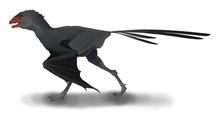

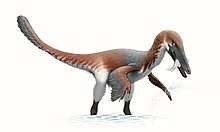
.png)



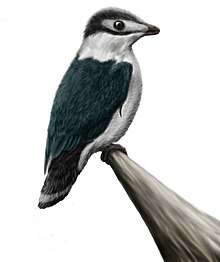

.png)

